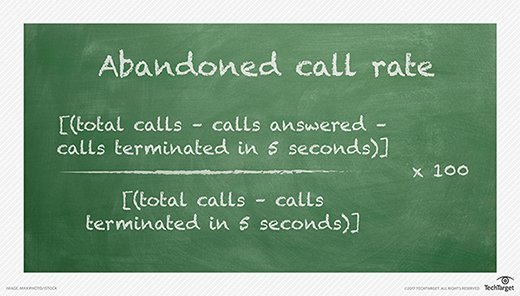
olly - Fotolia
How to calculate abandoned call rate for a contact center
Experts offer an abandoned call formula and advice on what to include when calculating call abandonment rates.
How do we calculate an abandoned call rate, and is there a benchmark for the length of time we should use before counting a call as abandoned?
Abandoned call rate typically measures the number of callers that hang up before an agent answers the phone.
Some contact centers don't include calls that are abandoned before their target service level in either the abandon rate or the service-level calculation. There is no set industry standard on either the time or whether to include it, however; this is a decision each center must make. Some centers also choose not to include short abandons that might indicate a wrong number or other factors out of the call center agent's control.
You should not count a call as abandoned for staff unless and until it has been sent to a queue for staff servicing. For example, you should not count calls as offered and abandoned in a self-service application, such as the interactive voice response system. Staff and queue abandonment rates should include only those calls that they have had the opportunity to answer.
How to calculate abandoned call rate
Abandoned call rate is expressed as a percentage of total calls, and many industries strive for an abandoned call rate of 5-8%. This measure can be useful in quantifying customer experience, comparing call center services and comparing the relative effectiveness of different customer service strategies.
However, it is important to note there are no universally agreed upon ways of calculating the call abandonment rate, which can lead to variations in the measurements.
Abandoned call rate formula
A basic formula for calculating the raw abandoned call rate is:
(total calls - calls answered) / (total calls) * 100
However, this does not account for callers who dialed the wrong number. It also does not account for callers who accidentally ended up in the accounting department when they really wanted technical support. Although these callers hung up, they did not abandon the call, so many organizations filter out these calls from the call abandonment rate.
Consequently, a better formula to represent call abandonment rate adds a filter to ignore calls when someone hangs up within 5-20 seconds. A shorter delay is more likely to represent a caller's intent. A longer delay may also discount people that hang up when they hear there is an expected wait time that exceeds their patience.

Most Automatic Call Distributor systems include the ability to add delays into their tools to automatically calculate the call abandonment rate. The modified formula for calculating call abandonment rate is the following:
Modified call abandonment rate % = (total calls - calls answered - calls terminated in 5 seconds) / (total calls - calls terminated in 5 seconds) * 100
Abandoned call rate calculation example
Here is an example of a calculated abandoned call rate:
If a call center receives 108 calls, with eight calls terminated in five seconds and 95 calls answered, that would equal five calls abandoned. Here it is broken down in the formula:
108 total calls - 8 calls terminated within 5 seconds - 95 calls answered = 5 calls abandoned
The call abandonment rate would thus be 5%.
5 / (108-8) * 100
Some organizations might also want to exclude calls terminated after a service announcement. For example, a power company suffering an outage might receive a significant spike in calls. Many of these callers will decide to hang up after hearing that the company is aware of the outage in their neighborhood. In these cases, the delay might temporarily be adjusted to reflect the fact that these callers resolved their call rather than abandoned it.
For example, if it takes 22 seconds to play a message alerting consumers about the awareness of an outage, the call abandonment rate calculation might add 30 seconds instead of the normal five. This would give callers 8 seconds to decide if their problem was already under consideration. That formula might look something like this:
Special modified call abandonment rate % = (total calls - calls answered - calls terminated in 30 seconds) / (total calls - calls terminated in 30 seconds) * 100
How to use the abandoned call rate
The call abandonment rate can be used for benchmarking a call center's operation, capacity planning and management of service-level agreements.
In the case of benchmarking, an organization might look at how a call center's time to answer correlates with the call abandonment rate. It could also look at how the call abandonment rate changes throughout the time of day or day of the week.
For example, an enterprise might find that when calls are delayed by more than a minute, then the call abandonment rate climbs from 3% to 20%. Benchmarking could also help an enterprise evaluate the effectiveness of new tools, like call-back technology, in reducing the abandoned call rate.
Information about the call abandonment rate and time to answer could also help guide management in capacity planning decisions. An enterprise might determine specific time windows when more agents are required to keep the call abandonment rate under a certain threshold.
In a sales-driven call center, the call abandonment rate could also be correlated with lost sales revenues. This would make it easier to justify a higher budget for more agents to meet these thresholds.
An abandoned call rate could also be used in contracting with outside call center services. In this case, the enterprise could set call abandonment rate thresholds as part of the contract to meet their expectations. It may also guide the vendor selection process when comparing two call center services that promise varying call abandonment rate service-level agreements.







